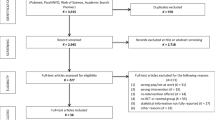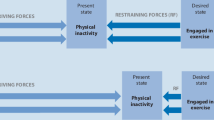Abstract
Objective
Work-related musculoskeletal disorders are prevalent in those who use computers, and education using ergonomic principles may be helpful to prevent such conditions. The present study sought to identify how an educational intervention based on the theory of planned behavior (TPB) may be effective for adopting healthy ergonomic postures.
Methods
A convenience sample of 162 computer users working in a hospital setting in Iran were randomly assigned to intervention or control groups. The intervention group (n = 81) received six weekly educational sessions based on TPB principles, whereas the control group received no intervention during the study period. Both groups were assessed at baseline and 3 months after the intervention using a TPB questionnaire, rapid office strain assessment (ROSA), and Nordic musculoskeletal questionnaire. Data were analyzed using the independent/paired Student’s t test, chi-square, and analysis of covariance.
Results
All TPB constructs in the intervention group improved from baseline to follow-up, indicating considerable progress compared to the control group (p < 0.001). More than 60% of intervention and control groups were categorized as high risk at baseline in terms of ergonomic posture measured by ROSA. This percentage was reduced to 21% for intervention group and increased to 65% in the control group at follow-up. Symptom relief was obtained for wrist/hands, lower back, neck, shoulders and upper back in the intervention group (all p < 0.05). The number of affected areas also significantly decreased in the intervention group compared to the control group three months after the intervention.
Conclusion
Educational programs based on TPB principles may be helpful in correcting ergonomic postures among computer users. Such interventions are recommended for worksite health promotion in that they may prevent the development of musculoskeletal disorders in staff.

Similar content being viewed by others
References
Baker NA, Redfern M (2009) Potentially problematic postures during work site keyboard use. Am J Occup Ther 63(4):386–397. https://doi.org/10.5014/ajot.63.4.386
Bernaards CM, Ariëns GA, Knol DL, Hildebrandt VH (2007) The effectiveness of a work style intervention and a lifestyle physical activity intervention on the recovery from neck and upper limb symptoms in computer workers. Pain 132(1–2):142–153. https://doi.org/10.1016/j.pain.2007.06.007
Bernal D, Campos-Serna J, Tobias A, Vargas-Prada S, Benavides FG, Serra C (2015) Work-related psychosocial risk factors and musculoskeletal disorders in hospital nurses and nursing aides: a systematic review and meta-analysis. Int J Nurs Stud 52(2):635–648. https://doi.org/10.1016/j.ijnurstu.2014.11.003
Borhany T, Shahid E, Siddique WA, Ali H (2018) Musculoskeletal problems in frequent computer and internet users. J Family Med Primary Care 7(2):337–339. https://doi.org/10.4103/jfmpc.jfmpc_326_17
Brink Y, Louw Q, Grimmer K (2020) Do changes in psychosocial factors, lifestyle factors and sitting posture influence the likelihood of musculoskeletal pain in high school computer users? Physiother Res Int 25(4):e1865. https://doi.org/10.1002/pri.1865
Choi J, Kim HS, Kim GS, Lee H, Jeon HS, Chung KM (2013) Posture management program based on theory of planned behavior for adolescents with mild idiopathic scoliosis. Asian Nurs Res 7(3):120–127. https://doi.org/10.1016/j.anr.2013.07.001
Constructing a TpB questionnaire: Conceptual and methodological considerations (2006) https://people.umass.edu/aizen/pdf/tpb.measurement.pdf. Accessed 20 Feb 2022
Douphrate DI, Gimeno D, Nonnenmann MW, Hagevoort R, Rosas-Goulart C, Rosecrance JC (2014) Prevalence of work-related musculoskeletal symptoms among US large-herd dairy parlor workers. Am J Ind Med 57(3):370–379. https://doi.org/10.1002/ajim.22286
Eijckelhof BH et al (2013) The effects of workplace stressors on muscle activity in the neck-shoulder and forearm muscles during computer work: a systematic review and meta-analysis. Eur J Appl Physiol 113(12):2897–2912. https://doi.org/10.1007/s00421-013-2602-2
Gholamnia-Shirvani Z, Ghofranipour F, Gharakhanlou R, Kazemnejad A (2018) “Women and active life”: an extended TPB-based multimedia software to boost and sustain physical activity and fitness of Iranian women. Women Health 58(7):834–850. https://doi.org/10.1080/03630242.2017.1342739
Glanz BK, Rimer BK, Viswanath K (2015) Health behavior: theory, research, and practice, 5th edn. Jossey-Bass Public Health, London
Ibrahim Z, Money AG (2019) Computer mediated reality technologies: a conceptual framework and survey of the state of the art in healthcare intervention systems. J Biomed Inform 90:103102. https://doi.org/10.1016/j.jbi.2019.103102
Kan MPH, Fabrigar LR (2017) Theory of planned behavior. In: Zeigler-Hill V, Shackelford TK (eds) Encyclopedia of personality and individual differences. Springer International Publishing, Cham, pp 1–8
Keykhaie Z et al (2014) Implementation of internet training on posture reform of computer users in Iran. Acta Informatica Medica 22(6):379–384. https://doi.org/10.5455/aim.2014.22.379-384
Khalili Z et al (2018) Effect of educational intervention on practicing correct body posture to decrease musculoskeletal disorders among computer users. J Educ Health Promotion 7:166. https://doi.org/10.4103/jehp.jehp_121_18
Kuo YL, Huang KY, Kao CY, Tsai YJ (2021) Sitting posture during prolonged computer typing with and without a wearable biofeedback sensor. Int J Environ Res Public Health. https://doi.org/10.3390/ijerph18105430
Maas ET, Koehoorn M, McLeod CB (2020) Descriptive epidemiology of gradual return to work for workers with a work-acquired musculoskeletal disorder in British Columbia, Canada. J Occup Environ Med 62(2):113–123. https://doi.org/10.1097/jom.0000000000001768
Mohammadian F, Asadi ZS, Moradinia M, Tajik R, Abhar R, Soleimanifar M (2020) The effect of theory-based educational intervention on correct principles of manual material handling among men. J Educ Health Promotion 9:319. https://doi.org/10.4103/jehp.jehp_242_20
Namnik N, Negahban H, Salehi R, Shafizadeh R, Tabib MS (2016) Validity and reliability of Persian version of the Specific Nordic questionnaire in Iranian industrial workers. Work (reading, Mass) 54(1):35–41. https://doi.org/10.3233/wor-162268
Parno A et al (2017) The prevalence of occupational musculoskeletal disorders in Iran: a meta-analysis study. Work (reading, Mass) 58(2):203–214. https://doi.org/10.3233/wor-172619
Pourtaghi G, Karimi Zarchi A, Valipour F, Assari A (2015) Ergonomic assessment using RULA technique in determining the relationship between musculoskeletal disorders and ergonomic conditions for administrative jobs in a military center. J Military Med 17(3):155–162
Rahmati-Najarkolaei F et al (2017) Determinants of lifestyle behavior in Iranian adults with prediabetes: Applying the theory of planned behavior. Arch Iran Med 20(4):198–204
Robertson MM, Ciriello VM, Garabet AM (2013) Office ergonomics training and a sit-stand workstation: effects on musculoskeletal and visual symptoms and performance of office workers. Appl Ergon 44(1):73–85. https://doi.org/10.1016/j.apergo.2012.05.001
Rodrigues MS, Sonne M, Andrews DM, Tomazini LF, Sato TO, Chaves TC (2019) Rapid office strain assessment (ROSA): Cross cultural validity, reliability and structural validity of the Brazilian-Portuguese version. Appl Ergon 75:143–154. https://doi.org/10.1016/j.apergo.2018.09.009
Saffari M, Emami Meybodi MK, Sanaeinasab H, Karami A, Pakpour AH, Koenig HG (2018) A theory of planned behavior-based intervention to improve quality of life in patients with knee/hip osteoarthritis: a randomized controlled trial. Clin Rheumatol 37(9):2505–2515. https://doi.org/10.1007/s10067-018-4120-4
Sanaeinasab H et al (2020) A theory of planned behavior-based program to increase physical activity in overweight/obese military personnel: a randomised controlled trial. Appl Psychol Health Well Being 12(1):101–124. https://doi.org/10.1111/aphw.12175
Sanaeinasab H et al (2018) The effectiveness of a model-based health education intervention to improve ergonomic posture in office computer workers: a randomized controlled trial. Int Arch Occup Environ Health 91(8):951–962. https://doi.org/10.1007/s00420-018-1336-1
Sarayloo K, Moghadam ZB, Saffari M, Esmaily H, Najmabadi KM (2019) The effect of educational program based on theory of planned behavior on health promotion and childbearing of minor thalassemia couples. J Educ Health Promotion 8:200. https://doi.org/10.4103/jehp.jehp_109_19
Senkowski V, Gannon C, Branscum P (2019) Behavior change techniques used in theory of planned behavior physical activity interventions among older adults: a systematic review. J Aging Phys Act 27(5):746–754. https://doi.org/10.1123/japa.2018-0103
Speklé EM et al (2010) Effectiveness of a questionnaire based intervention programme on the prevalence of arm, shoulder and neck symptoms, risk factors and sick leave in computer workers: a cluster randomised controlled trial in an occupational setting. BMC Musculoskelet Disord 11:99. https://doi.org/10.1186/1471-2474-11-99
Sullivan GM, Feinn R (2012) Using effect size-or why the P value is not enough. J Grad Med Educ 4(3):279–282. https://doi.org/10.4300/JGME-D-12-00156.1
Vashishtha R, Holmes J, Pennay A, Dietze PM, Livingston M (2022) An examination of the role of changes in country-level leisure time internet use and computer gaming on adolescent drinking in 33 European countries. Int J Drug Policy 100:103508. https://doi.org/10.1016/j.drugpo.2021.103508
Waersted M, Hanvold TN, Veiersted KB (2010) Computer work and musculoskeletal disorders of the neck and upper extremity: a systematic review. BMC Musculoskelet Disord 11:79. https://doi.org/10.1186/1471-2474-11-79
WHO (2004) Appropriate body-mass index for Asian populations and its implications for policy and intervention strategies. Lancet (london, England) 363(9403):157–163. https://doi.org/10.1016/s0140-6736(03)15268-3
Acknowledgements
The authors would like to express their especial thanks for hospital managers and staff who helped us to conduct the study.
Funding
This research did not receive any specific grant from funding agencies in the public, commercial, or not-for-profit sectors.
Author information
Authors and Affiliations
Corresponding author
Ethics declarations
Conflict of interest
There is no conflict of interests to declare.
Additional information
Publisher's Note
Springer Nature remains neutral with regard to jurisdictional claims in published maps and institutional affiliations.
Rights and permissions
Springer Nature or its licensor holds exclusive rights to this article under a publishing agreement with the author(s) or other rightsholder(s); author self-archiving of the accepted manuscript version of this article is solely governed by the terms of such publishing agreement and applicable law.
About this article
Cite this article
Valipour, F., Mirzahosseini, S.A.H., Saffari, M. et al. Health education using the theory of planned behavior to modify ergonomic posture in hospital computer users: a randomized controlled trial. Int Arch Occup Environ Health 96, 167–178 (2023). https://doi.org/10.1007/s00420-022-01882-4
Received:
Accepted:
Published:
Issue Date:
DOI: https://doi.org/10.1007/s00420-022-01882-4




